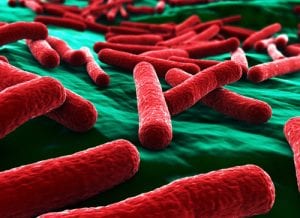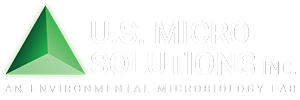Escherichia Coli is a Common Intestinal Bacteria
 E. coli is a Gram negative anaerobic, rod-shaped, coliform bacteria of the genus Escherichia, commonly found in the lower intestine of humans and animals.
E. coli is a Gram negative anaerobic, rod-shaped, coliform bacteria of the genus Escherichia, commonly found in the lower intestine of humans and animals.
Most varieties are harmless. Some cause brief diarrhea. There are, however, a few serious strains such as E. coli O157:H7, which results in severe abdominal cramps, vomiting, and bloody diarrhea. Such virulent E. coli is known as STEC, Shiga toxin producing e. coli. Shiga is one of the most potent bacterial toxins known.
The concentrations of Gram negative bacteria in indoor environments, including food preparation and storage areas, depends on a number of factors. These include the number and activity levels of individuals in the space, the types of clothing worn by individuals, the ventilation rate of the space, the presence of animals, and the presence of standing water.
In cleanrooms and ISO-classified areas, the main source of microbial contamination is personnel and, to a lesser extent, materials transfer and infiltration of contaminated air.
E. Coli in Contaminated Food and Water
Food borne illness outbreaks, such as the contamination of Romaine lettuce announced by the CDC in November of 2018 often make headlines as they affect many states or even cross national borders. Of course, contamination can be limited and local in nature.
The most commonly contaminated foods are ground beef, unpasteurized milk, and fresh produce (spinach and lettuce are particularly vulnerable to E. coli contamination).
Private wells, swimming pools, and naturally occurring water sources like lakes and streams provide breeding grounds for E. coli. Some outbreaks have been linked to contaminated municipal water supplies.
It is also possible to transmit E. Coli through personal contact, especially when hands are not properly washed.
Other Types of Escherichia
Other species of Escherichia are found in the environment as well as the gastrointestinal tract of warm-blooded organisms. E. hermannii and E. vulneris are found in human wound infections, as well as being isolated from other body sites. E. fergusonii is most often isolated from human feces, and E. blattae is a commensal organism of cockroaches, but is not recovered from human specimens.
Environmental Testing
Environmental laboratory testing of food preparation and storage areas can aid in identifying threatening Escherichia coli species. E. coli O157:H7 has been shown to survive in a range of environments and under various conditions. The risk of infection from contaminated surfaces is significant, especially because only a low bacterial load is required to cause sickness.
At U.S. Micro Solutions, our microbiology laboratory is a licensed, accredited source for thorough, cutting edge environmental testing, including USP 797, Legionella, indoor environmental testing, healthcare & medical testing, water analysis, and identification of specific pathogens. Visit our Laboratory Services page to learn more.
Give us a call at 724-853-4047 or contact us online via our Contact page.

